Our Skomer Island trip was part of our 3-day Pembrokeshire itinerary in early June and was the perfect time to see these colourful characters.
Wild animal encounters and being out and about in nature are one of our favourite activities, but spending time among the Skomer Island puffins was one of our top wildlife experiences in the UK.
Join us as we share this fabulous experience and info on how you can arrange your own Skomer Island visit.
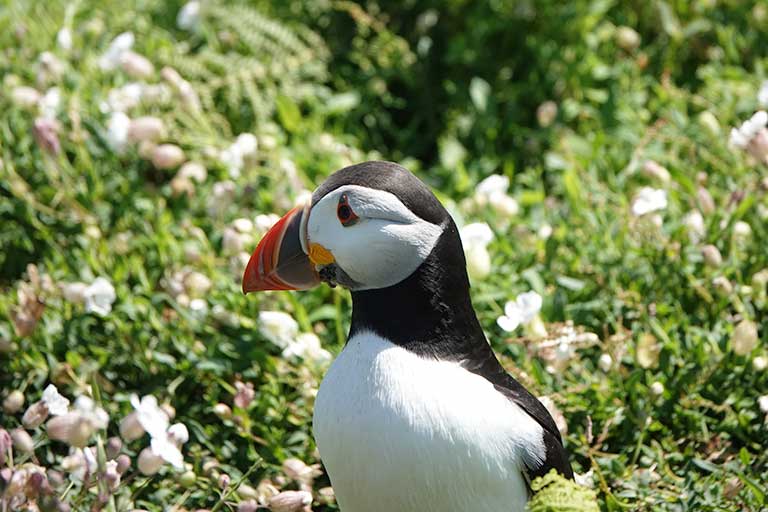
Visiting Skomer Island Puffins: In a Nutshell 🥜
Essential Info for Your Visit:
- Best Time to Visit: April to July, with peak sightings in June.
- Location: Skomer Island, accessible via a 15-minute ferry from Martin’s Haven.
- Ferry and Landing Fees: Approximately £40 per person (varies by month).
- Booking: Essential to pre-book online.

Travel Tips for a Smooth Trip:
- What to Pack: Camera with zoom, sturdy walking shoes, waterproof gear.
- Visitor Guidelines: Follow marked paths to protect wildlife, especially puffin burrows, and adhere to all Wildlife Trust guidelines.
- Accessibility: There are 80+ steep steps to climb on arrival at the island
- Bring a packed lunch and water as you will be on Skomer Island for around five hours, as no refreshments are available.
- Facilities: Skomer Island is a nature reserve with limited facilities. No shops or cafes. There is a small farmhouse/Hostel and one toilet block.
- Take all of your rubbish with you – there are no rubbish bins on the island.
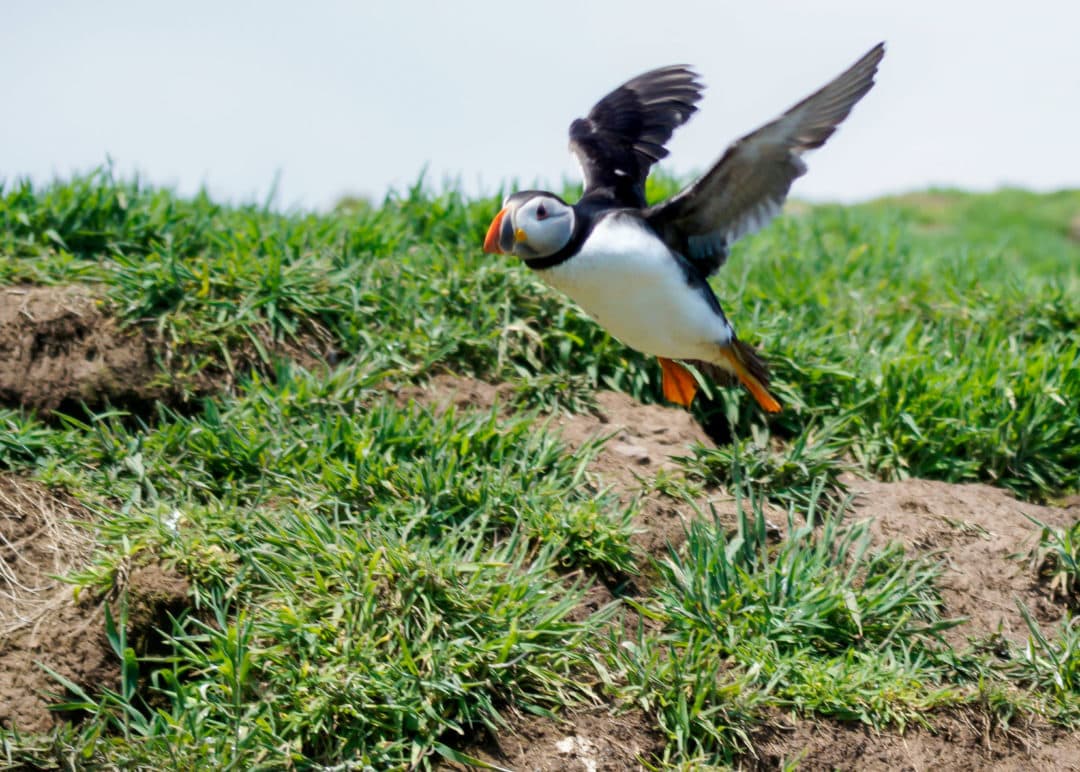
Highlights of a Visit:
- Wildlife Watching: Encounter puffins up close at The Wick, observe other seabirds, and possibly spot marine life like grey seals.
- Photography Spots: Best views for photographers are at The Wick, where puffins fly in with beaks full of eels.
- Natural Beauty: Enjoy the island’s wildflowers and coastal scenery during your walks.
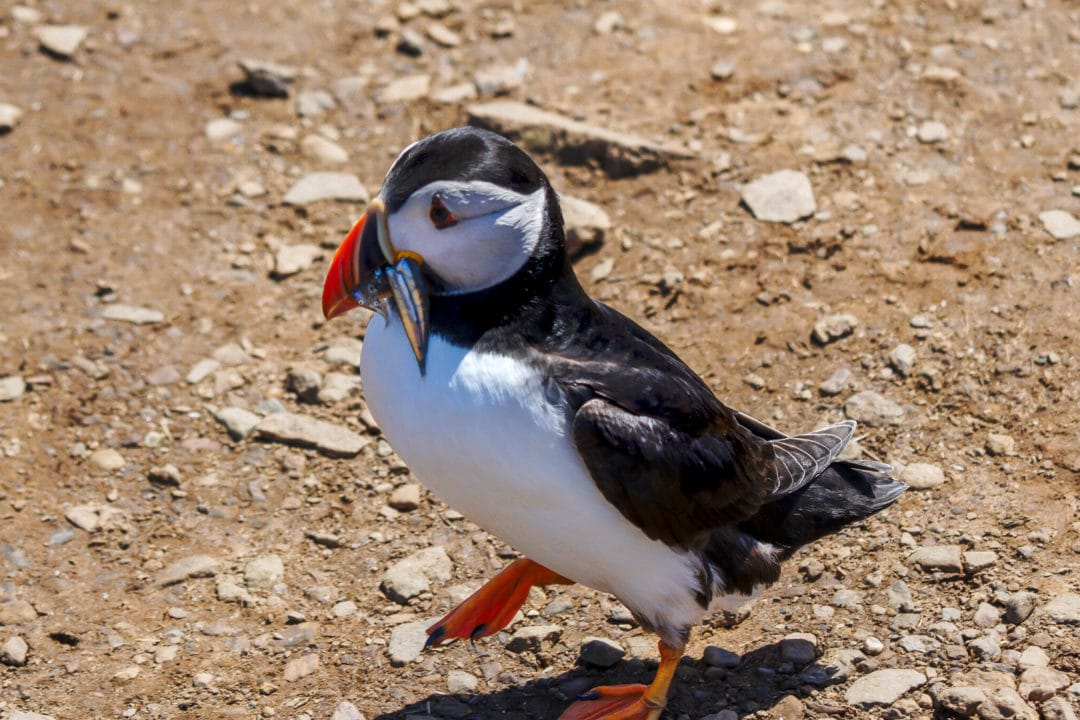
Planning a Trip to the UK?
- 🚗 Hiring a car? We recommend getting a quote from DiscoverCars
- 🚐 Hiring a campervan? We recommend Motorhome Republic
- ⛑ Arranged your travel insurance? Compare quotes from World Nomads & Safetywing
- 🪪 Order your International Driver’s Licence online here
- 🏩 Booked your accommodation? We use Booking.com to find the best deals
- 🐾 Is someone pet-sitting for you? 🐾 We use and love TrustedHousesitters
- (Get 25% off at checkout for new memberships with our discount code: LIFEJOURNEY25)
A Little Bit About Skomer Island
This Skomer Island Nature Reserve is managed by the Wildlife Trust with a particular highlight being the many island puffins.
The waters around it have been designated a Marine Conservation Zone and it is the only protected section of water in Wales.
The island is one of the few places in the world where puffin numbers have increased in recent years. Wardens counted just under 42,000 puffins in April 2024, which is similar to 2023, but previous years have seen increases.
Billing is when Puffins playfully tap each other’s beaks when swinging their heads from side to side, a form of courtship behaviour.
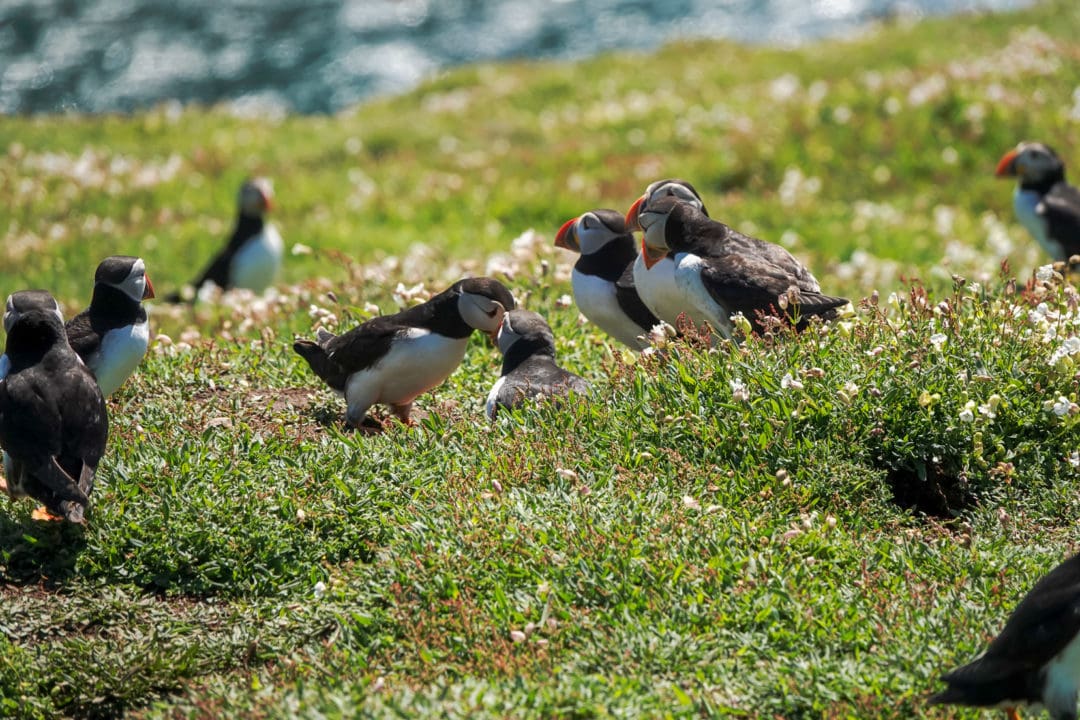
While you’re on Skomer Island, take your time to just simply watch the antics of the puffins.
They are so interesting, whether you see a Puffin squirting poo, gathering grass for its burrow or showing affection to its mate by ‘billing’, there always seems to be plenty going on in these busy little fellow’s life.
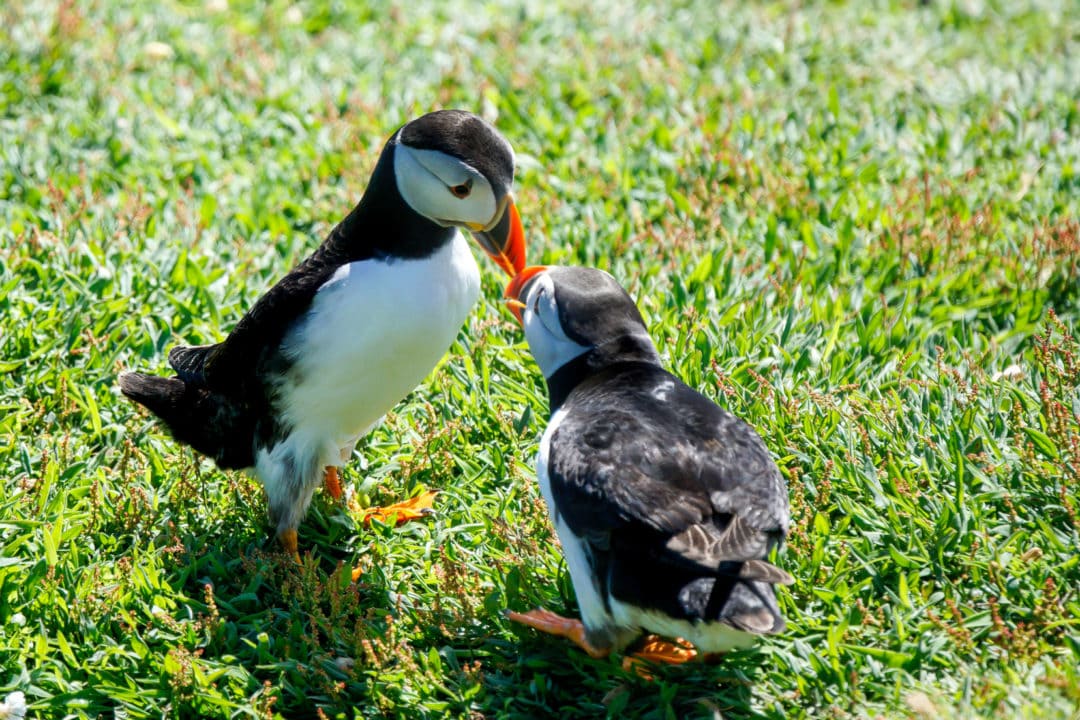
Our Video: Puffin Fun on Skomer Island
Watch our fun video snippets of these little cuties going about their puffin business on Skomer Island in Wales.
A Puffin Welcome to Skomer Island
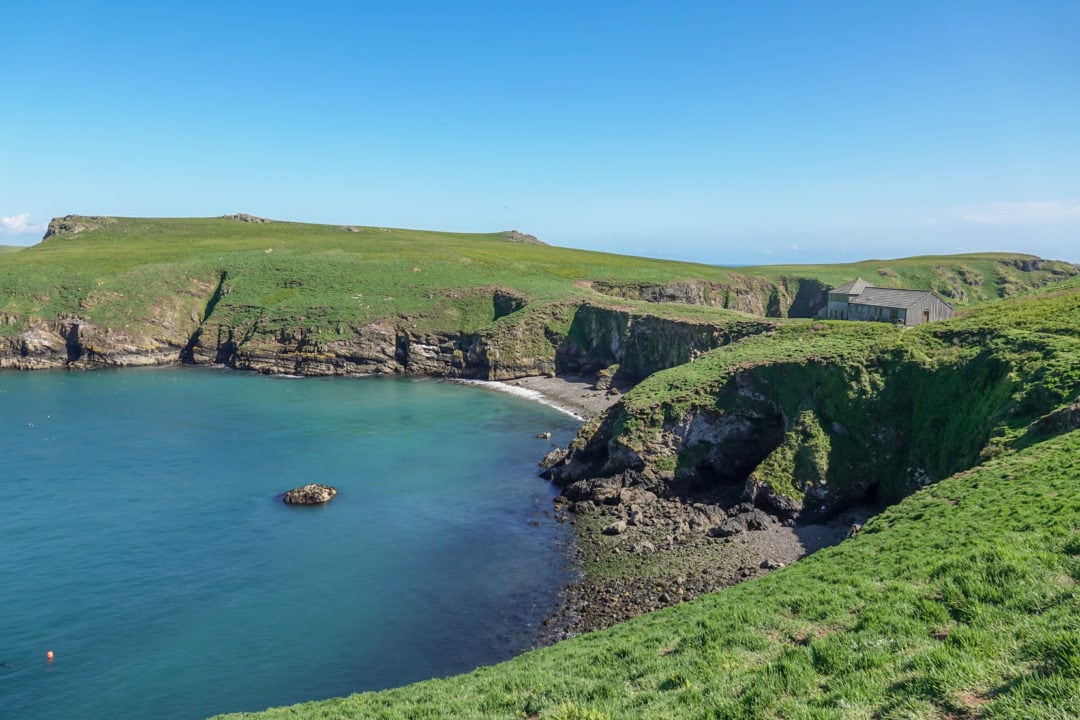
The landing point for the boat at Skomer Island is at North Haven. If you haven’t spotted the puffins flying overhead or floating in the water as you arrive on the boat, then it is here that you are likely to get your first close-up view of these colourful little fellows.
We arrived in early June when the puffins had started collecting sand eels for their young chicks and were flying past us at a rate of knots!
If you visit earlier than June, the puffins may not be so visible flying around because they will be busy building their nests and digging their burrows for egg laying rather than feeding their hatched chicks (which happens from early June).
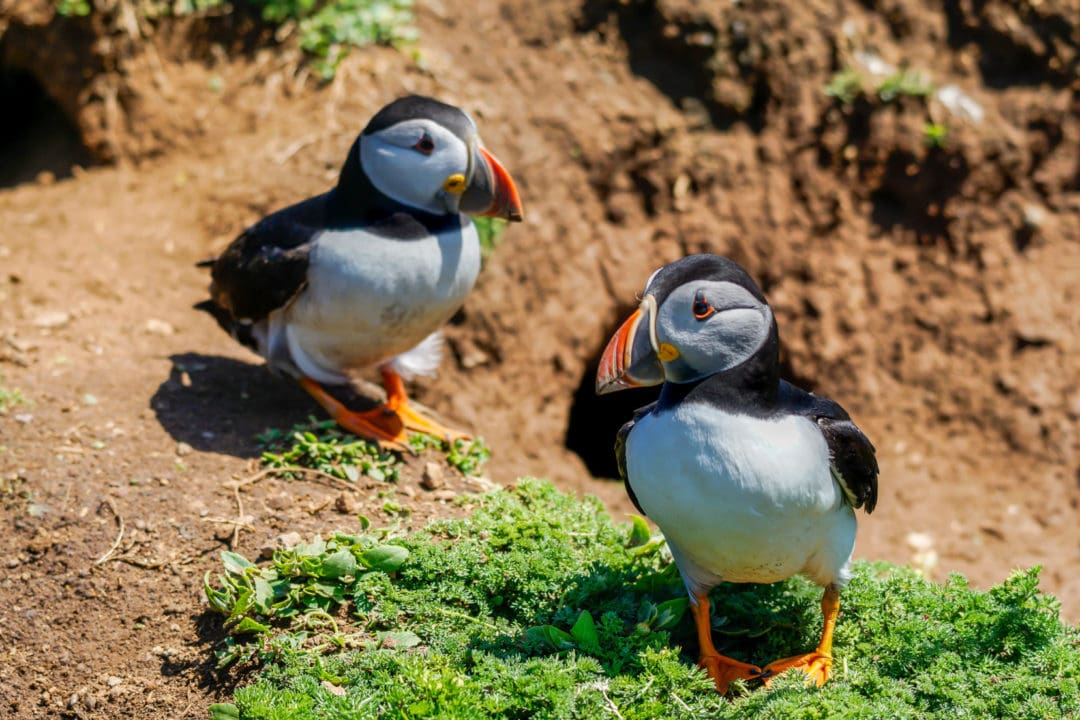
Skomer Island Walking Trail
Skomer Island has a 6.5-kilometre walking trail around the island and a trail that crosses through the centre of the island. Therefore, depending on your preference, you can choose a longer or shorter route.
If you choose to walk the full trail, as we did, it takes approximately 2.5 – 3 hours. It took us about 4 hours because we stopped frequently to take photographs.
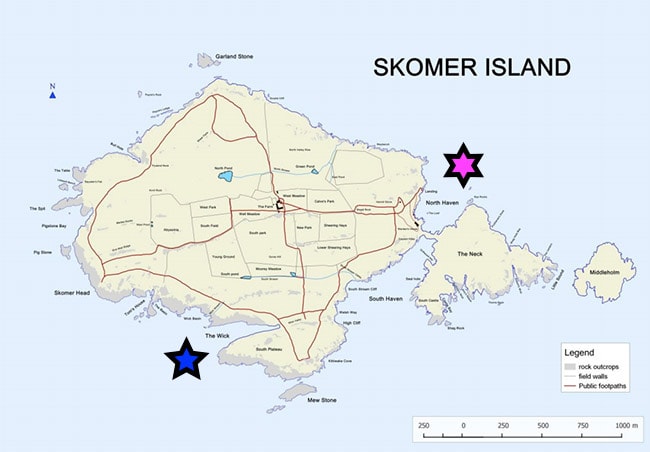
The pink star on the map above shows the North Haven boat landing point.
The blue star shows ‘The Wick’, a fabulous clifftop location where puffins launch themselves to sea, returning with beaks full of sand eels, scurrying past your feet to feed their young in the nearby burrows.
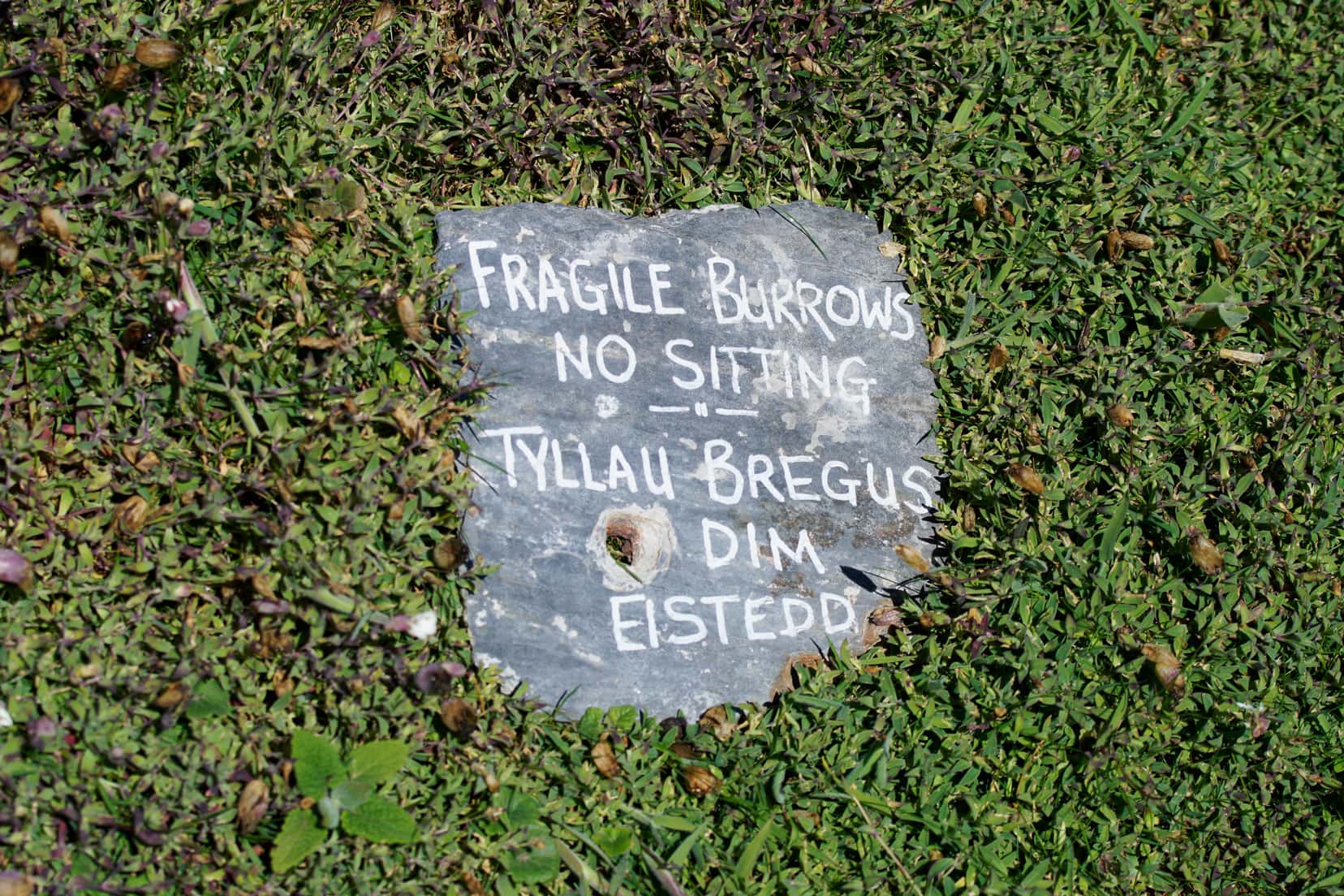
Best Places for Skomer Puffin Photography
You can see the Skomer Island Puffins almost anywhere on the island, but they are more prolific in certain areas.
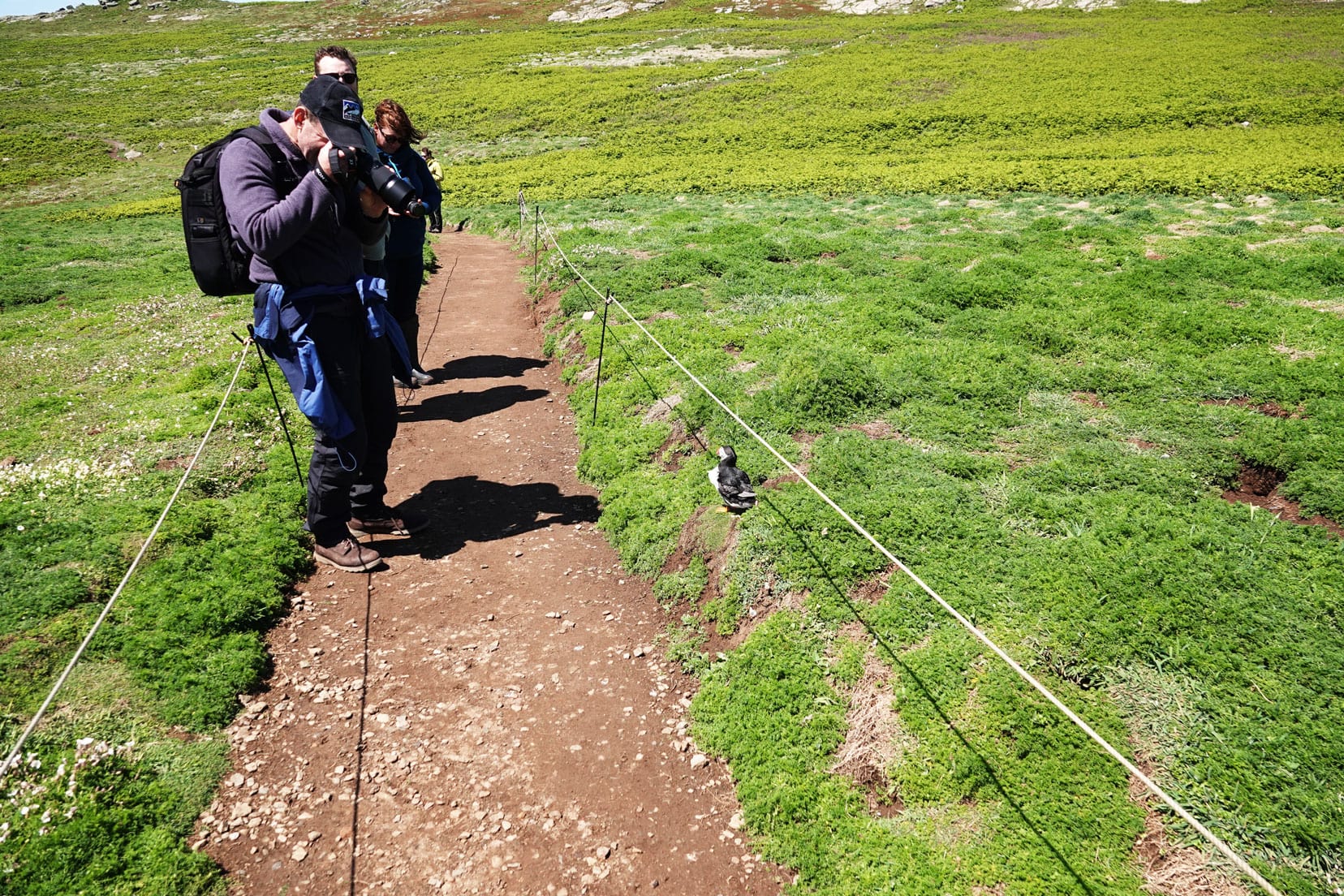
The Wick at Skomer
‘The Wick’, on the southwestern side of the island, in a setting of cliffs perfect for Puffin photography, is the best place to capture airborne puffins.
Here, puffins use the updraughts to take off from the land in their hunt for sand eels. They can fly at about 80 kilometres per hour, and their little wings flap incredibly fast. Standing near The Wick cliff face, felt like we were surrounded by hundreds of tiny dive bombers.
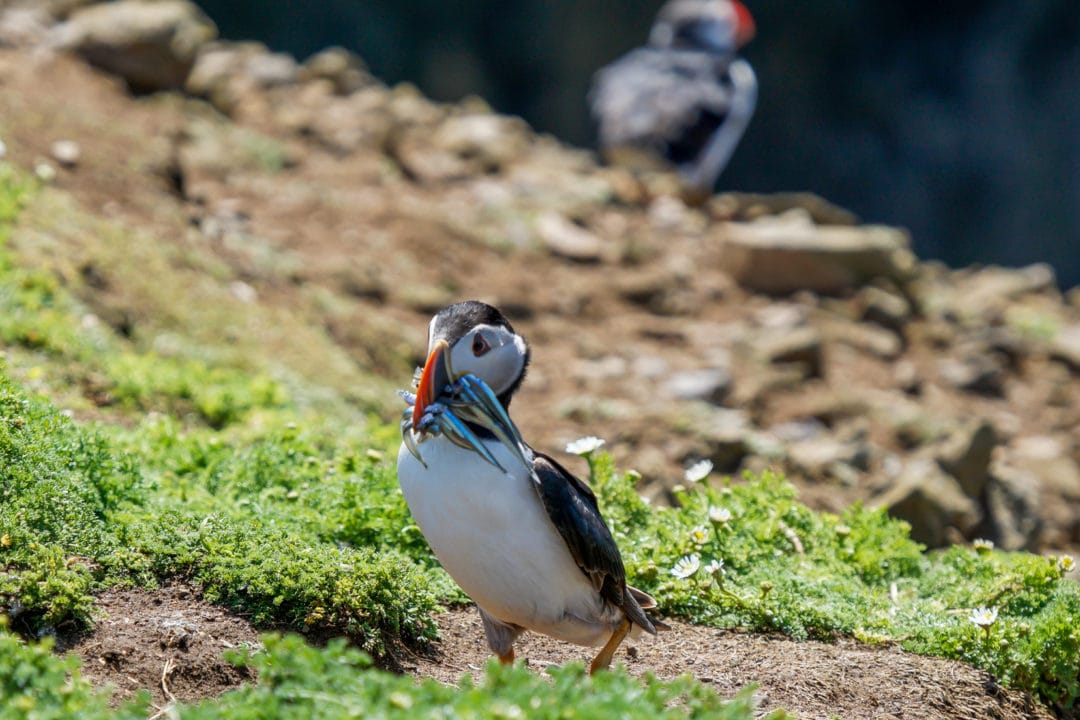
Hundreds of birds are here, both around the burrows, clustering on the cliff edge and in the air. It was incredible how fast they flew by, and capturing them while in the air was a huge challenge.
The blur of black and white, with a glint of silver (from the sand eels in their beak), may be all you catch before you see the Puffin clumsily land and waddle into its burrow with its catch.
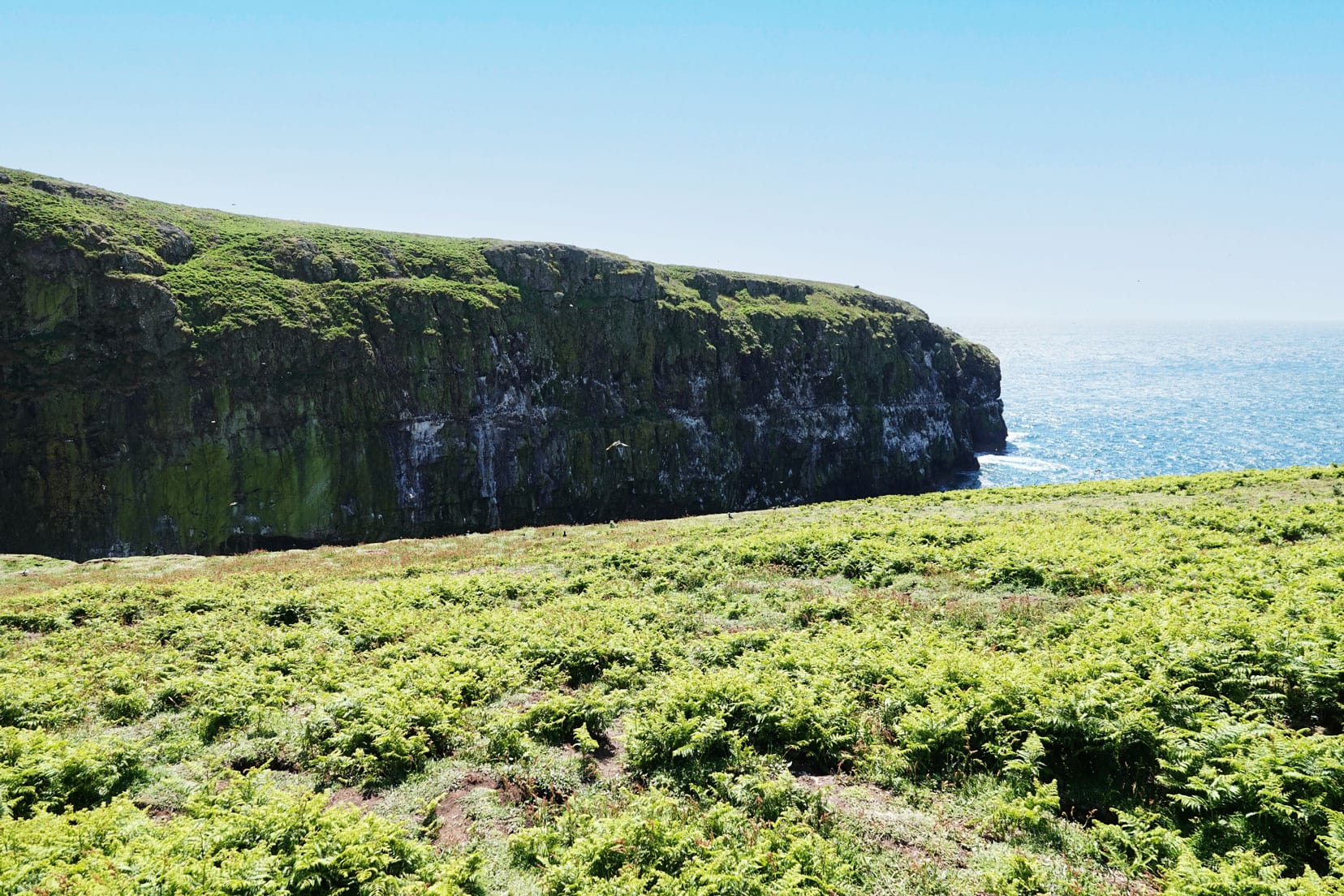
Here was a great place to photograph the returning puffins with their beaks filled with sand eels.
You have to be quick, though, because once they land, they shuffle quickly to their nests to feed their hungry pufflings.
Many of the Puffins seem happy to waddle between your feet, and some appear quite intrigued by these rather large beings with their big zoom lenses, which may seem like oversized beaks to them. We caught this little fellow literally ‘on camera’.
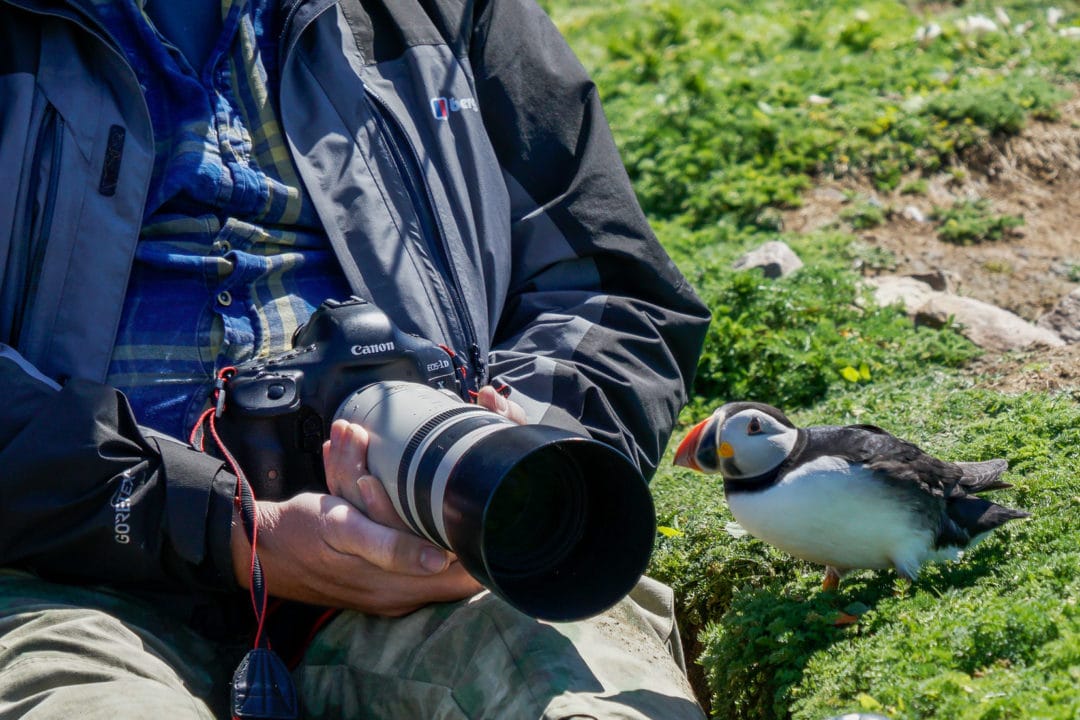
We didn’t want to leave this area at The Wick, but it’s important not to spend too much time here so that the puffins don’t become overwhelmed and to make room for the other visitors who also want to experience these incredible creatures.
We couldn’t believe we had the special privilege of watching these amazing creatures go about their everyday lives so close to us.
You’ll get some great shots here, but it is really important not to move towards the Puffins when they are flying into land with their beaks full of eels.
If frightened, they may hover too long and fall prey to a gull or drop the eels and not have enough food for their chicks.
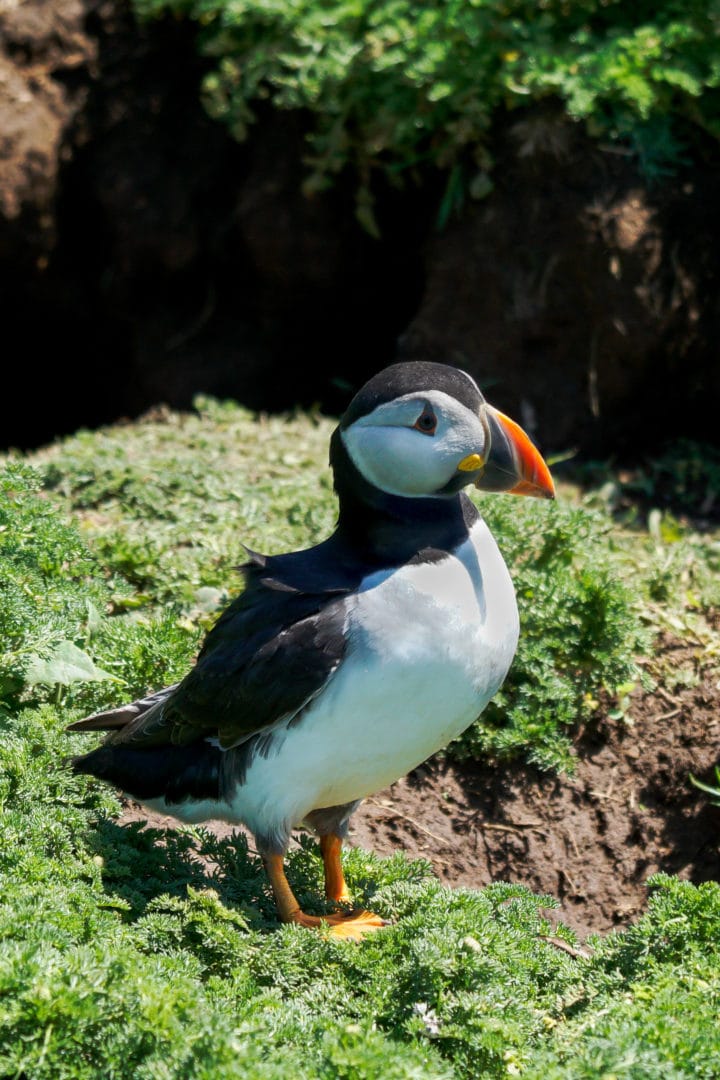
What camera gear is recommended for photographing Puffins on Skomer Island?
A telephoto or zoom lens with a camera that can shoot at a high frame rate is recommended to capture stunning shots of flying Puffins and other seabirds. The Puffins can be found at various distances from visitors, so a lens with good zoom capabilities will ensure you can get up-close shots without disturbing the birds.
▶ Related: Our Camera Gear We Use on Our Travels
Will You See Baby Puffins at Skomer?
A baby puffin is called a puffling – which is adorable – but it is unlikely that you will see one while on Skomer Island. They remain in their burrow and, when mature, leave the nest under cover of darkness to head out to the Atlantic Ocean to start their own life, only returning about 3 years later to begin the cycle again.
You can see a baby puffling being gently lifted out of its burrow here in this BBC Nature Video
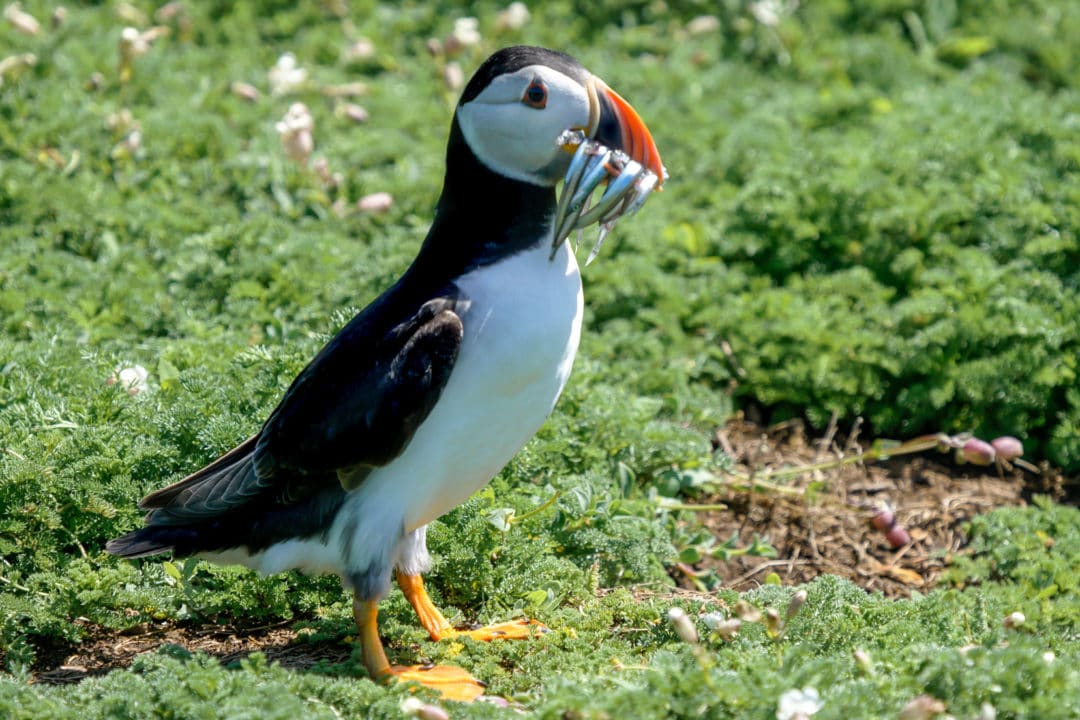
Skomer Island Puffin Facts
- The Skomer Island Puffins are Atlantic Puffins
- There are about 25,000 – 30,000 breeding puffins on Skomer
- Puffins live for about 20 to 35 years
- Puffins bond with one mate for life
- A puffin lays one egg per year
- A baby Puffin is called a Puffling
- The Puffins have sharp claws with which to dig their burrows
- A Puffin spends its first three years of life at sea
What’s the Best Time to see Puffins on Skomer Island?
The Puffins arrive on Skomer Island Nature Reserve in April to begin nesting and leave again at the end of July. During this period, the island becomes home to over 25,000 breeding Puffins, making it an ideal time to witness these adorable seabirds in their natural habitat.
Once on land, the puffin digs a burrow using its sharp claws on its feet and its beak. The egg is laid in the burrow on a feathers and soft grass nest.
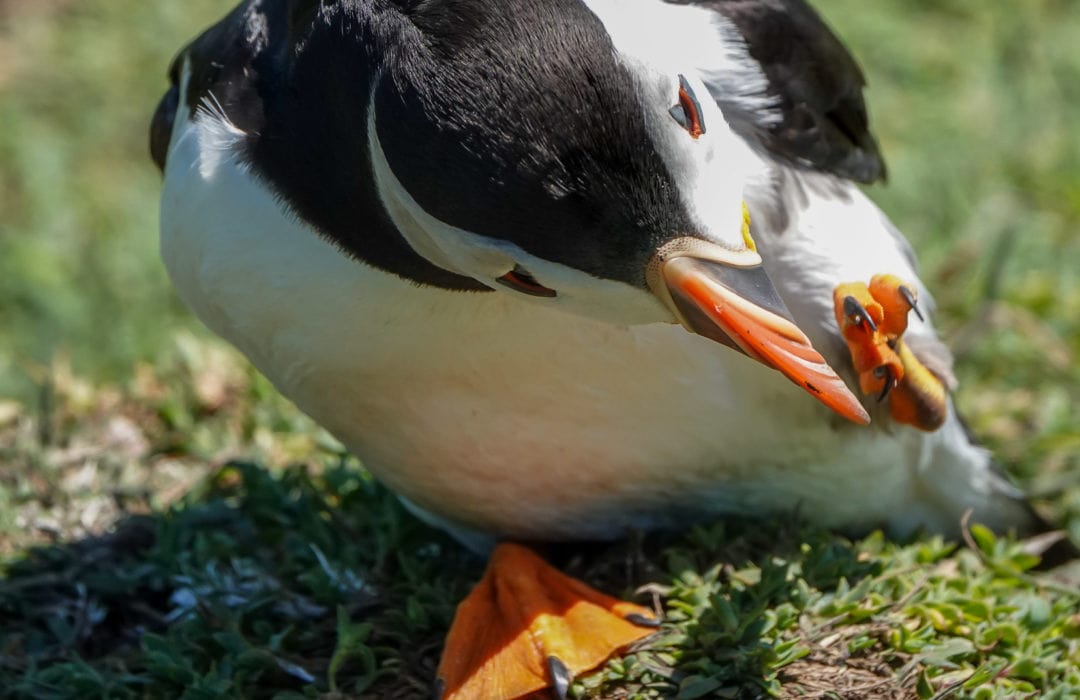
Once the egg hatches, after about 40 days, the parents feed the chick regularly. They can be seen returning to the burrow with mouthfuls of silvery sand eels. Due to their specialised beaks, the puffins can carry about ten sand eels per trip.
These amazing little seabirds are busy feeding their chicks between June and mid-July.
If you visit in May, you’ll be arriving at the peak flowering time for the Bluebells, but even in early June, we were lucky enough to see some of the late-flowering Bluebells and other wildflowers.
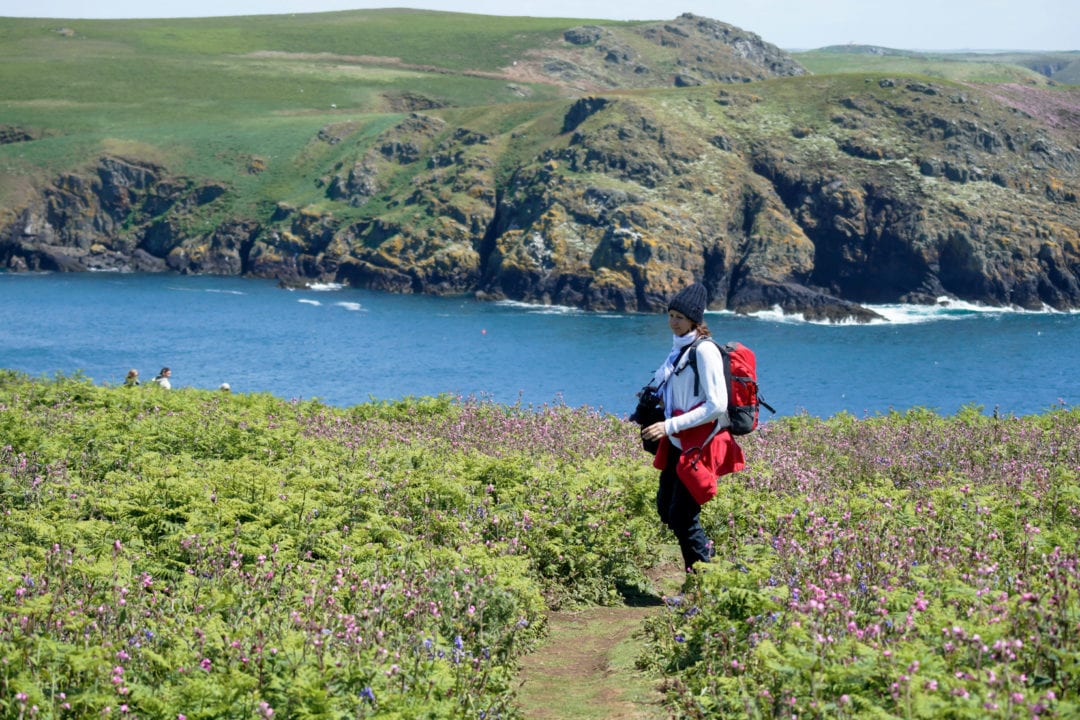
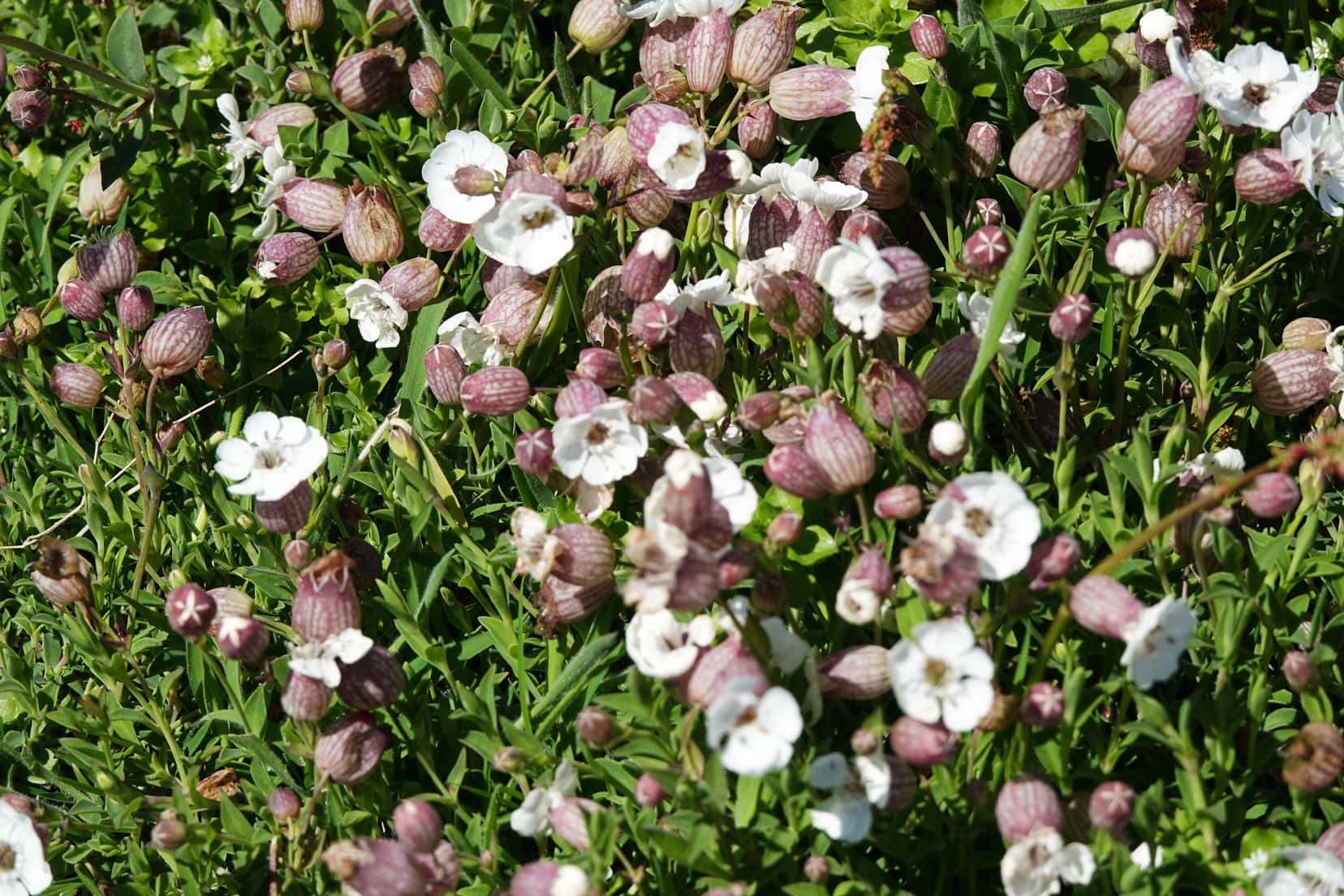
Can I spot Puffins in other locations in Pembrokeshire?
While Skomer Island is one of the prime locations to see Puffins in Pembrokeshire, you may also spot them on other islands and coastal areas in the region. Some additional spots known for Puffin sightings include Skokholm Island and the coastal cliffs along the Pembrokeshire Coast Path.
What Other Wildlife Can You See on Skomer Island?
You might be surprised to learn that Puffins aren’t the only attractions on Skomer Island – although, in my opinion, they are the cutest!
Other than the popular puffins, you can spot several other seabirds, birds of prey, and other wildlife on your trip to Skomer.
Manx Shearwaters
One of the largest breeding populations of Manx Shearwaters in the world is found on Skomer Island. Around 350,000 breeding pairs nest there. However, you’re unlikely to see one of these seabirds as they only leave their burrows at night, avoiding their main predator, the Great Black-backed Gull.
Although we didn’t see a live one, we saw quite a few Manx shearwater remains scattered around the island.
Razorbills and Guillemots
As we arrived at North Haven, we saw many razorbills and guillemots nesting on the cliffs to the left and right of the pathway.
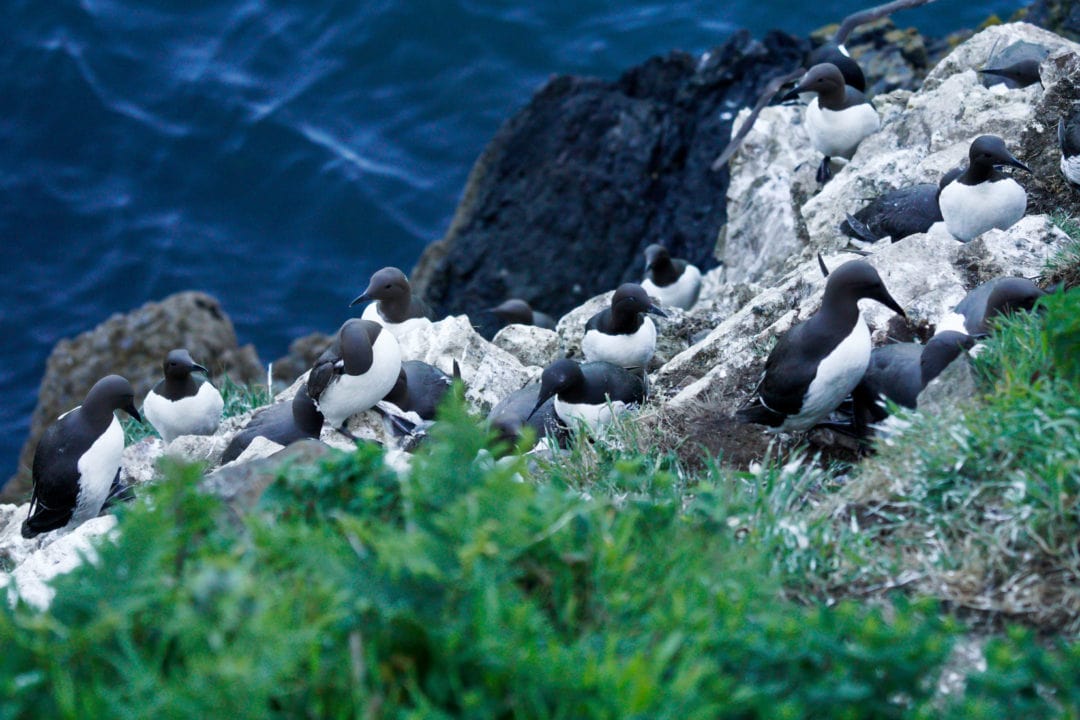
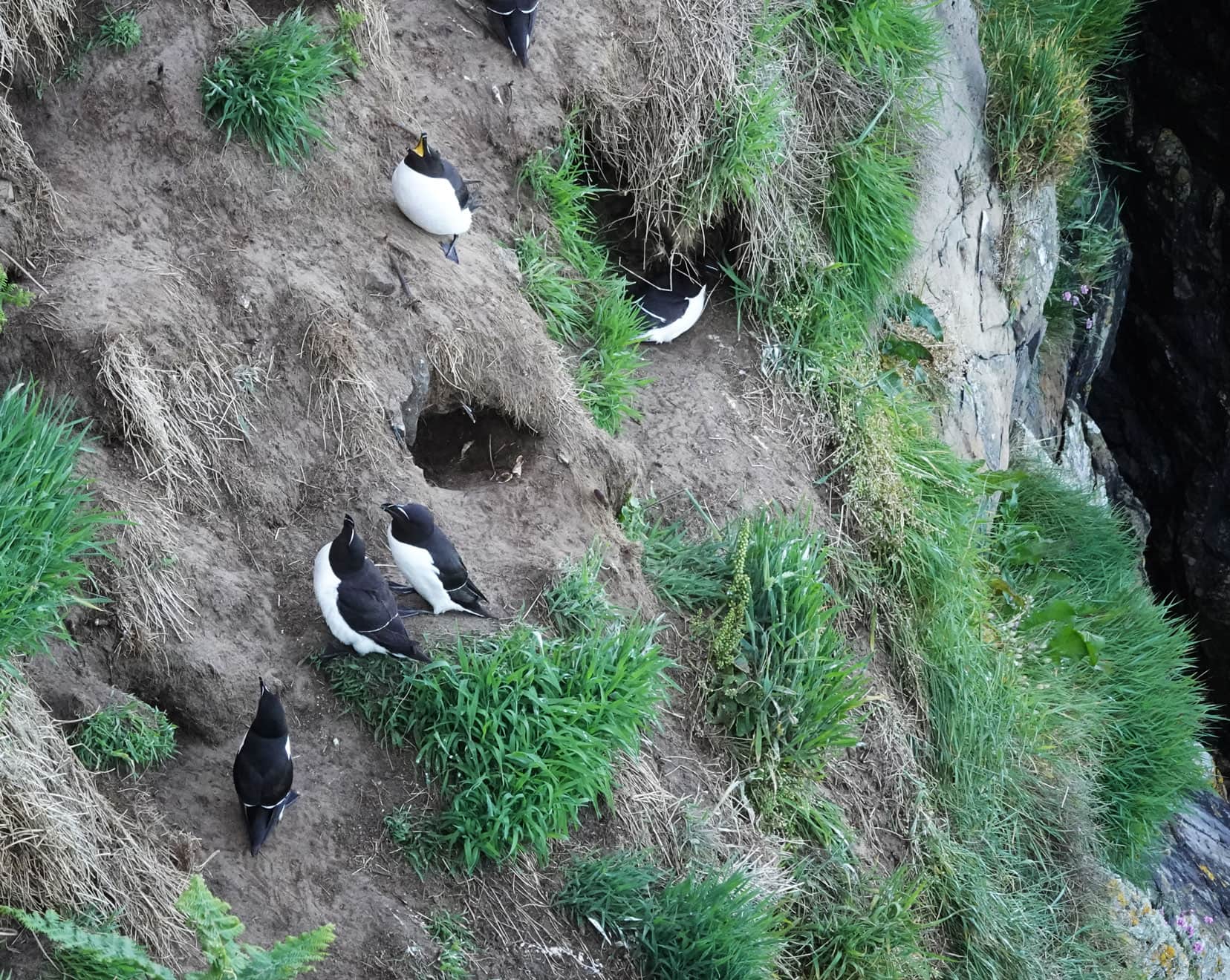
Other Birds on Skomer Island
Among the other birds you might spot are Oystercatchers, Fulmars, Gannets, Shags, Cormorants, Kittiwakes, Herring Gulls and the Lesser and Great Black-Backed Gulls.
And if you are lucky, you might also spot Peregrin Falcons, Buzzards or Short-eared owls.
▶ Related: Impressive Falcon Display at Dunrobin Castle, Scotland
Grey Seals / Porpoises / Dolphins
On our arrival at Skomer Island, a Grey Seal lay nonchalantly on a rock nearby. We didn’t take a photo as we assumed we would see plenty more, but as it happened, that was our only sighting for the day.
You may also spot dolphins while watching the ocean from the clifftops.
Rabbits on Skomer
Sharing the burrows with the puffins and seemingly unperturbed by this annual influx of Puffins are hundreds of rabbits.
We saw plenty hopping among the Puffins, all going about their business as one happy little community. There are estimated to be about 10,000 rabbits on Skomer Island.
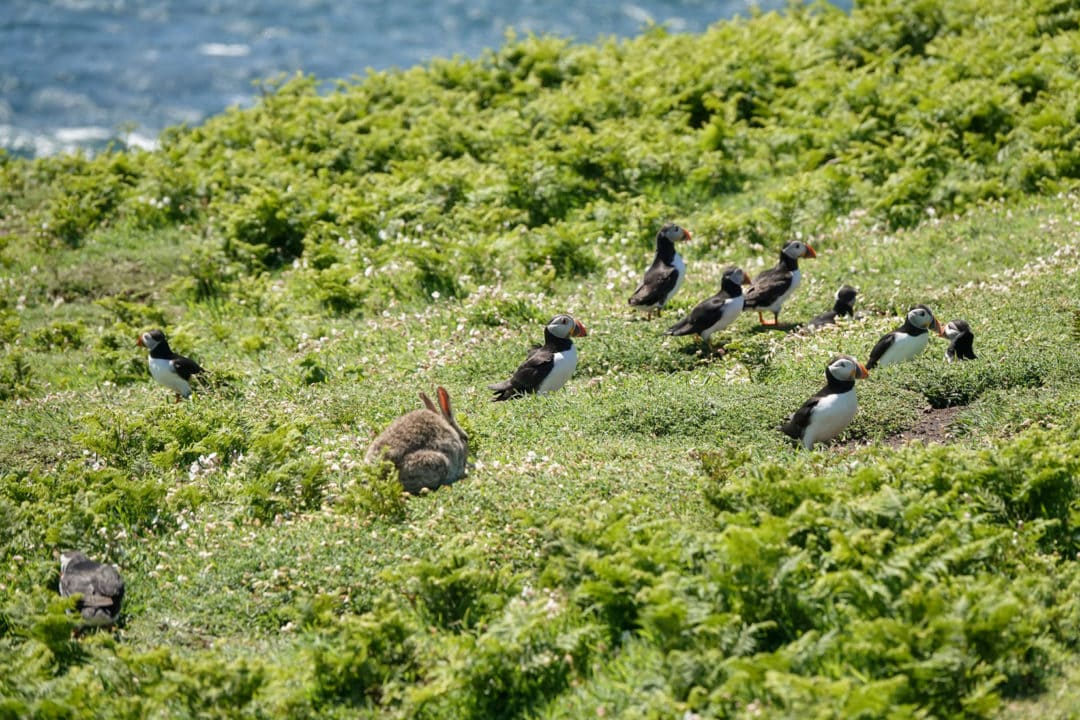
Practical Visiting Tips and Information
Where is Skomer Island?
Skomer Island, in Southwest Wales, is just off the wild Pembrokeshire coast. It’s one of the most accessible and important seabird breeding sites in Europe.
▶ READ MORE: Puffins on Handa Island in Scotland
How to Book and Buy Skomer Island Tickets
Buying tickets for Skomer used to involve queuing at Lockley Lodge super early to get a ticket for later that day. However, there is now an online booking system, and tickets can be bought in advance.
- Tickets must be pre-booked and bought online (do this early as they can book out quickly)
- The cost is £40 per person in April and July, £44 in May/June, and £30 in August/September— the price includes boat fare and landing fee.
- Landing tickets are strictly limited to a total of 250 visitors per day.
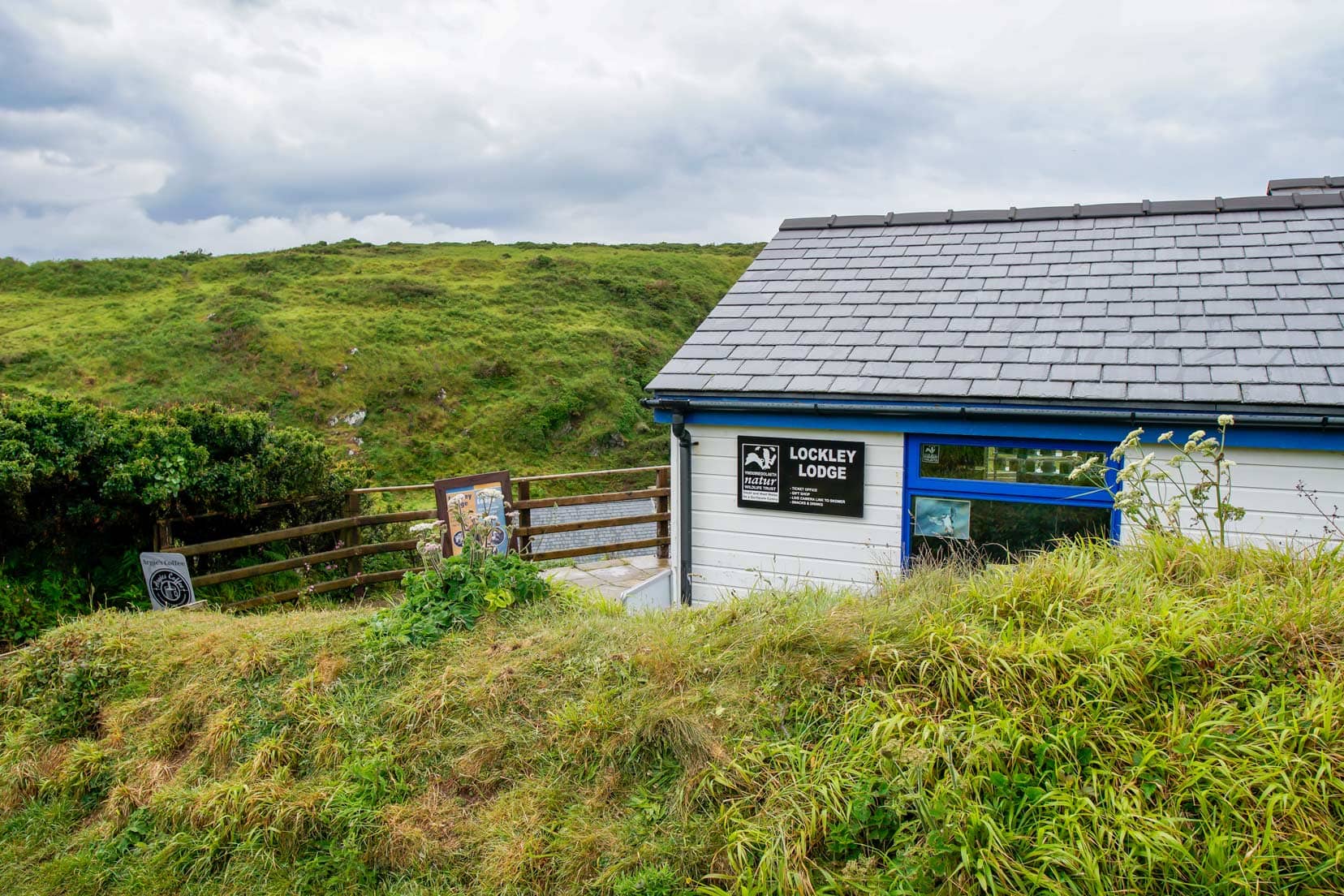
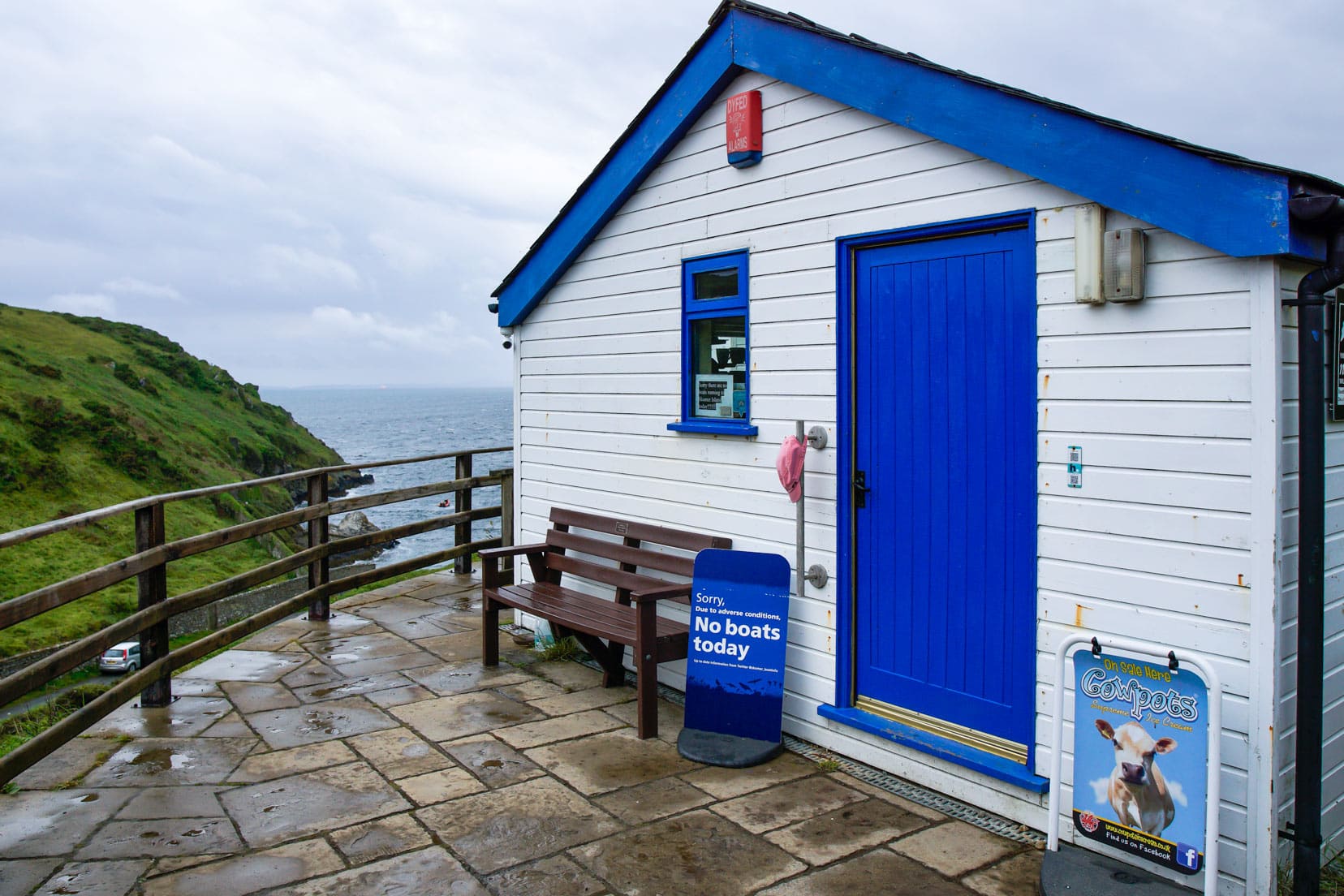
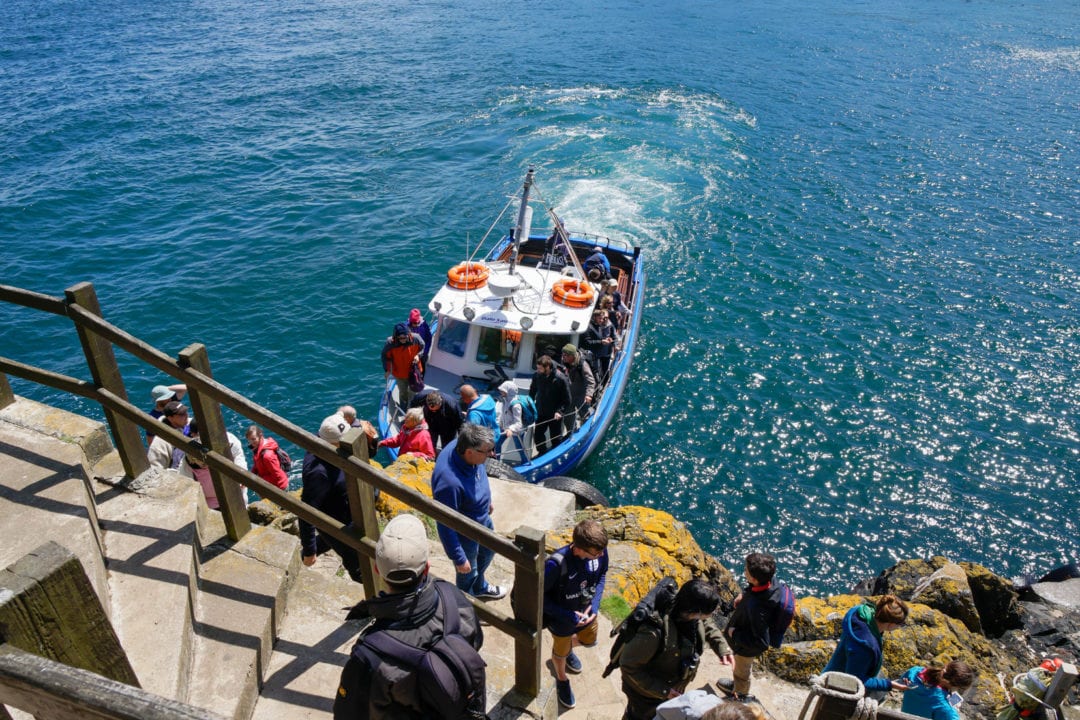
Overnight Accommodation on Skomer Island
Do you fancy overnighting on Skomer Island?
If so make sure to book plenty of time in advance as it’s a popular hostel to stay in. An old farm on the island offers three-star self-catering hostel accommodation with a communal kitchen, lounge area and library.
- Between April to the 1st of September, overnight stays are two nights or three nights in duration
- The Whitsun Bank Holiday in May is a 3-night stay only.
Accommodation Near Skomer Island
The Lobster Pot Inn in Marloes has good reviews and ratings and is near Skomer Island.
Other accommodations nearby include:
- ⛱ North Headborough B&B | ⭐️ 9.7/10 Ratings | 🛏 Book Here
- ⛱ Mill Haven Place Glamping-Yurt 2 | ⭐️ 9.5/10 Ratings | ⛺️ Book Here
- ⛱ Timber Hill Self-Catering Lodges | ⭐️ 8.9/10 Ratings | 🍽 Book Here
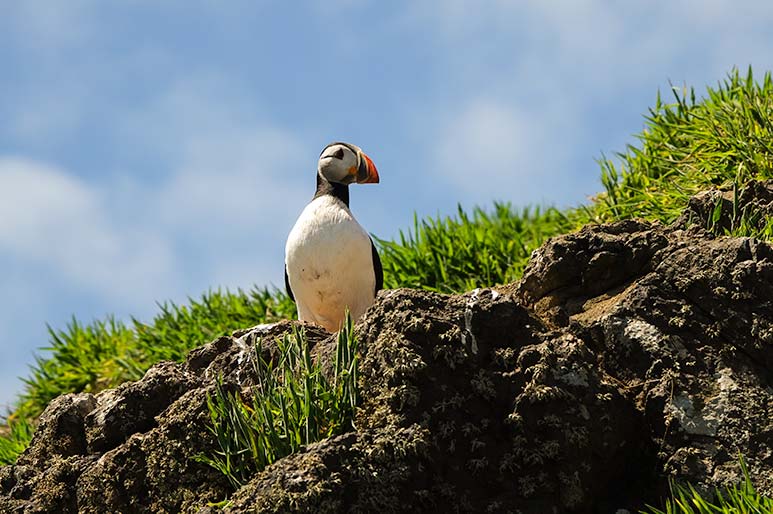
Getting to Skomer Island
Skomer Island is accessible by a 15-minute ferry ride from Martin’s Haven on the southwestern Pembrokeshire Coast in Wales.
The ferries run from 1st April to 30th September at various times in the morning. Booking must be done online and includes the price of the boat trip and the landing on Skomer Island.
By Car
Lockley Lodge is at Martin’s Haven, near Marloes in Pembrokeshire, Wales.
When you reach Marloes, drive through the village and continue for approximately two miles before parking in the National Trust car park on your left.
For satellite navigation, the postcode is SA62 3BJ which gets you within 300 metres of Lockley Lodge Visitor Centre.
There is a National Trust car park at the Visitor Centre. It is free for National Trust members and £ 7.00 per day for non-members.
After paying, you can come and go during the day using the same ticket.
By Public Transport
To get to the Visitor Centre using public transport, the newly formed on-demand transport operator ‘ Fflecsi Pembrokeshire‘ is now available. The service operates in both the north-west and south-west Pembrokeshire anytime between 7.30 am and 6.30 pm (Monday to Saturday).
Customers book by downloading the Fflecsi App (available on Apple and Android devices) or by phoning 0300 234 0300 (Monday-Saturday from 7 am to 7 pm and on Sundays: 9 am to 6 pm).
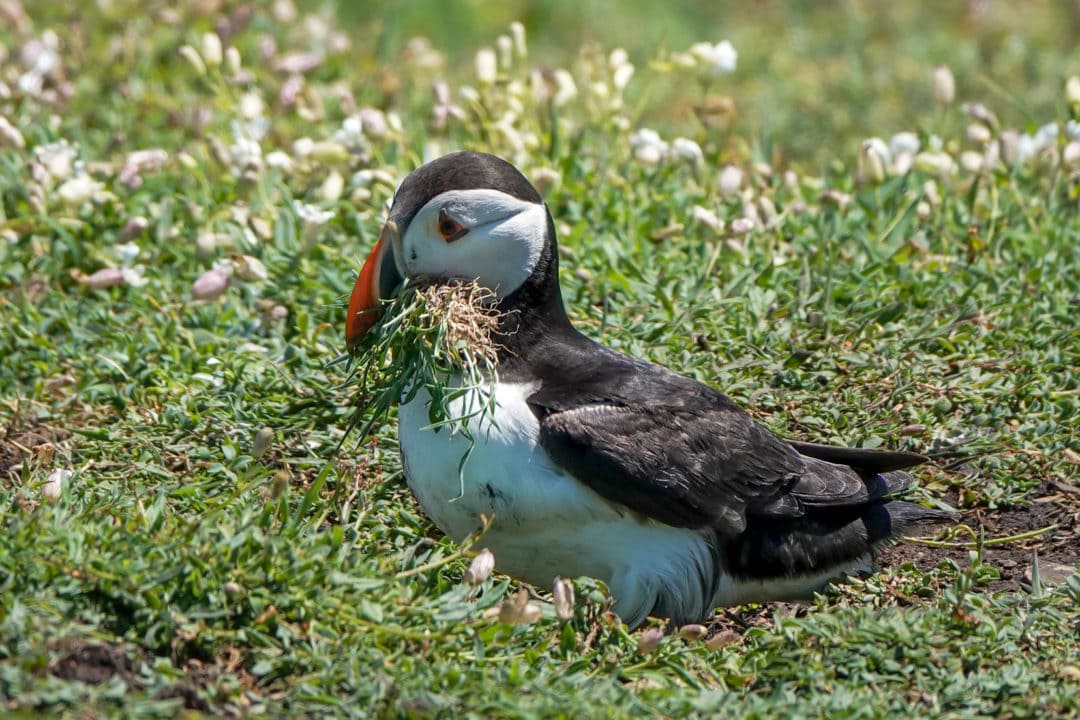
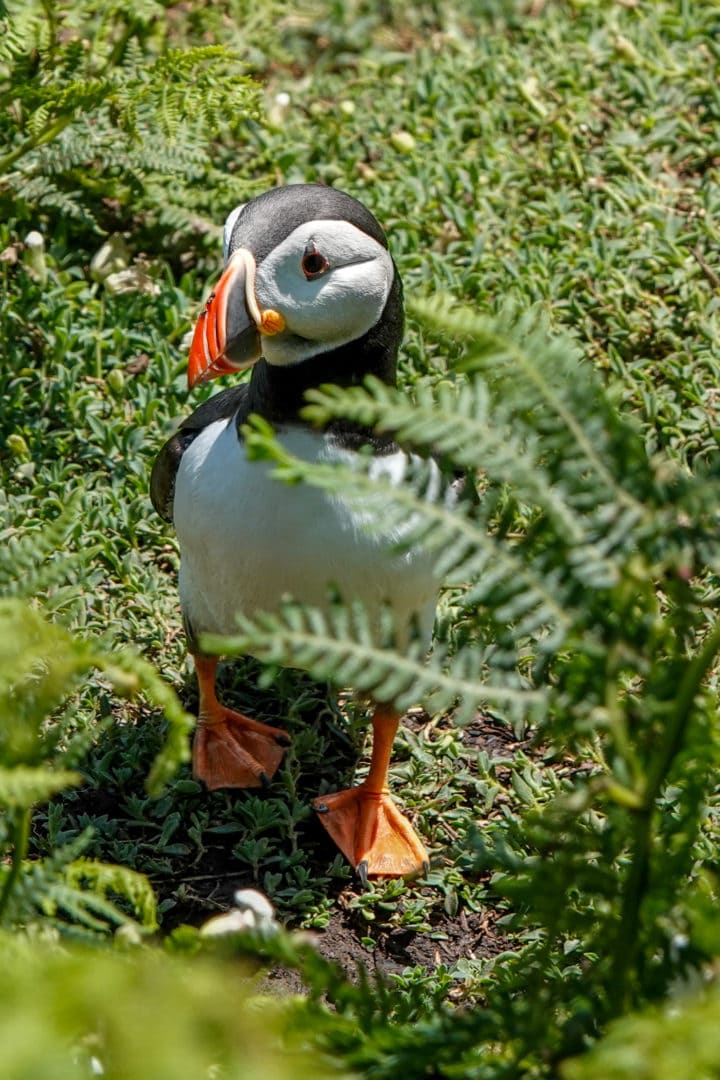
Conservation Efforts for Puffins on Skomer
The puffin colonies in the North Sea, around Norway and Iceland, have suffered greatly in recent years. Many cannot find enough food to feed their chicks, so thousands of chicks and eggs have been abandoned.
Marine environmentalists suggest the lack of sand eels (the Puffin’s primary food source) is due to rising sea temperatures.
Therefore, paying strict attention to signs and following the rules of Skomer Island will help protect these marvellous puffins.

Want to Adopt a Skomer Island Puffin?
Yes, you can adopt a puffin!
Adopting a puffin will help with the ongoing conservation work of the island. You’ll receive an adoption pack and ongoing reports about your puffin.
It’s a great way to be involved and make a difference with these amazing birds.
Find out how to adopt a puffin, and if you sign up, you will receive the following:
- Introductory letter
- Personalised Certificate
- Fact Sheet
- Cuddly Puffin Soft Toy
Skomer Island Puffins … That’s a Wrap
Our visit to see the Skomer Island Puffins was an experience beyond compare. These charming little creatures enthused us as they went about their daily routines on the island.
From witnessing their delightful poses to capturing their adorable antics on video, we were mesmerized by these cuties.
With its 6.5-kilometre walking trail, Skomer Island offers breathtaking views and a chance to spot other wildlife like Manx Shearwaters, Razorbills, and Guillemots.
As we marvelled at the puffins’ colourful plumage and watched them tend to their burrows and chicks, we couldn’t help but appreciate the dedicated conservation efforts being made to protect these precious creatures.
Have any questions? Drop us a comment below or share your experience of Skomer Island puffins.
Read more:
- Newburgh Seal Beach, Scotland
- Birds in Kruger National Park: Winged Wonders Inc. video
- Animals In Kruger – Inc. Video
- Rocamadour Monkey Forest- France
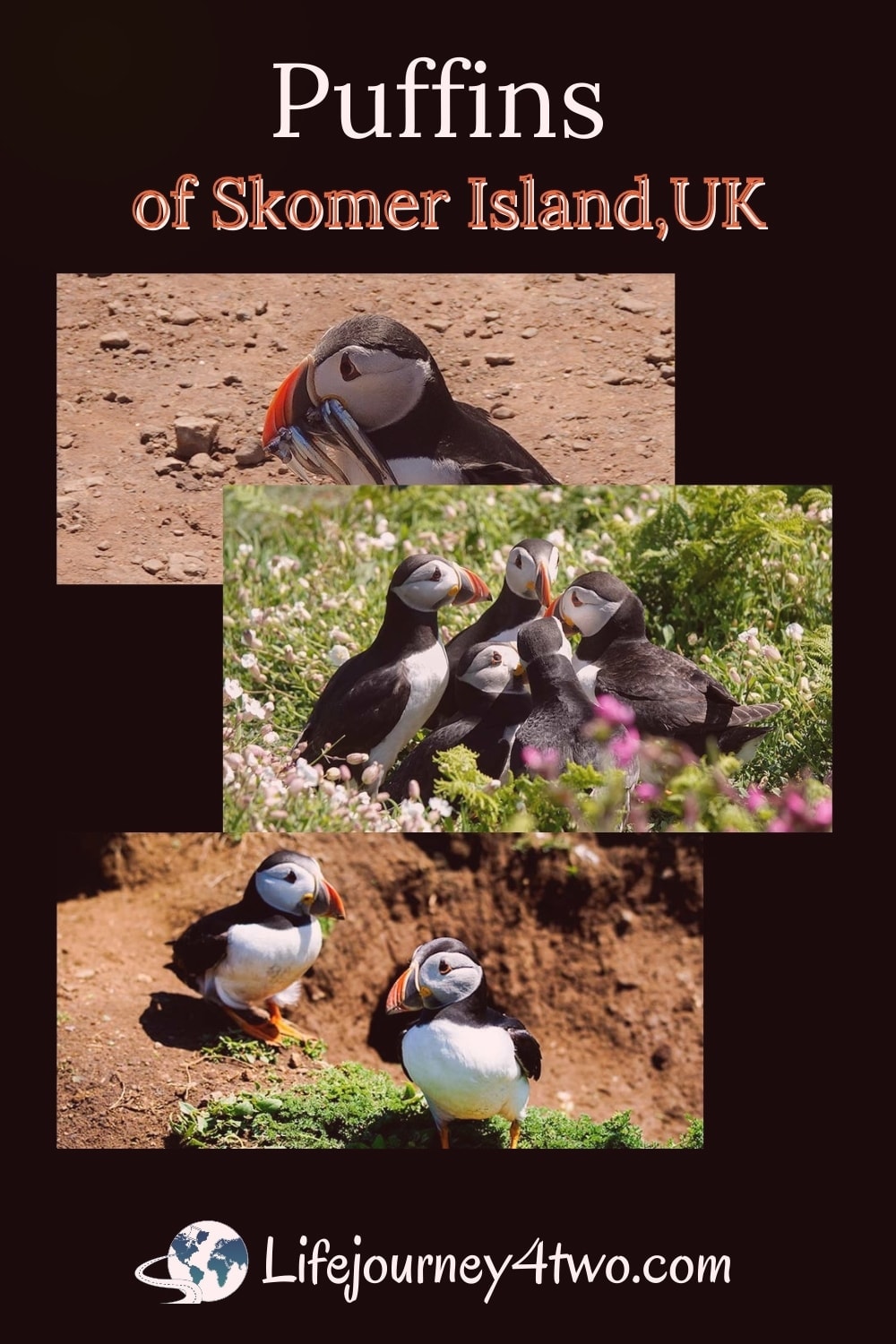
Planning Your Travels?
These are the travel resources we recommend and use when planning our trips.
- 🚘 Car Hire: We use DiscoverCars.com
- Motorhome/Campervan Rental: We highly recommend the Motorhome Republic
- 🪪 Order your International Driver’s Licence online here
- 🛏 Book Accommodation: We use Booking.com to find accommodation that suits our budget
- 🐶 Pet Sitting/Pet Sitters: Check Out TrustedHousesitters here (Use our Discount code: LIFEJOURNEY25 for 25% off. )
- Activities and Experiences: Get Your Guide and Viator
- Travel Insurance: Safetywing or World Nomads
- 🥾 Travel Gear and Accessories: Check out our top picks here — Lifejourney4two page on Amazon
For a more thorough list, visit our Travel Resources page here.


5
What a beautiful place!!! Would love to visit with my kids one day.
It is absolutely mesmerising watching the puffins Edel and the environment is beautiful. Such a wonderful experience, for kids and adults alike. Thanks so much for reading 🙂